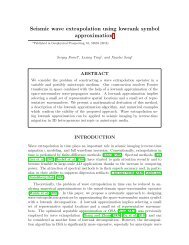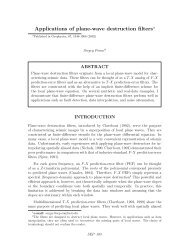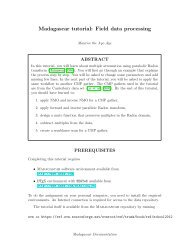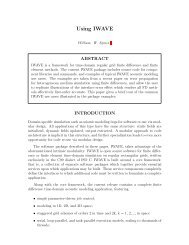pdf - Madagascar
pdf - Madagascar
pdf - Madagascar
You also want an ePaper? Increase the reach of your titles
YUMPU automatically turns print PDFs into web optimized ePapers that Google loves.
2<br />
2. Suppose that we use the gradient operator for data interpolation:<br />
min |∇m| 2 . (2)<br />
This approach roughly corresponds to minimizing the surface area and represents<br />
the behavior of a soap film or a thin rubber sheet.<br />
The corresponding inverse model covariance operator is the negative Laplacian<br />
C −1<br />
m = ∇ T ∇ = −∇ 2 . The corresponding covariance operator corresponds to<br />
the Green’s function G(x) that solves<br />
In 2-D, the Green’s function has the form<br />
with some constant A.<br />
−∇ 2 G = δ(x − x 0 ) . (3)<br />
G(x) = A − ln |x − x 0|<br />
2π<br />
To derive equation (4), we can introduce polar coordinates around x 0 with the<br />
radius r = |x−x 0 | and note that the Laplacian operator for a radially-symmetric<br />
function φ(r) in polar coordinates takes the form<br />
Away from the point x 0 , solving<br />
∇ 2 φ = 1 r<br />
1<br />
r<br />
d<br />
dr<br />
d<br />
dr<br />
(<br />
r dφ )<br />
dr<br />
(4)<br />
(5)<br />
(<br />
r dG )<br />
= 0 (6)<br />
dr<br />
leads to G(r) = A + B ln r. To find the constant B, we can integrate ∇ 2 G<br />
over a circle with some small radius ɛ around the origin and apply the Green’s<br />
theorem<br />
∫∫<br />
−1 =<br />
∮<br />
∇ 2 Gdx dy =<br />
∇G · ⃗ds =<br />
∫ 2π<br />
0<br />
∂G<br />
∂r<br />
∣ ɛ dθ = 2π B . (7)<br />
r=ɛ<br />
Derive the model covariance function G(x) which corresponds to replacing equation<br />
(2) with equation<br />
min ∣ ∣ ∇ 2 m ∣ ∣ 2 (8)<br />
and approximates the behavior of a thin elastic plate.











